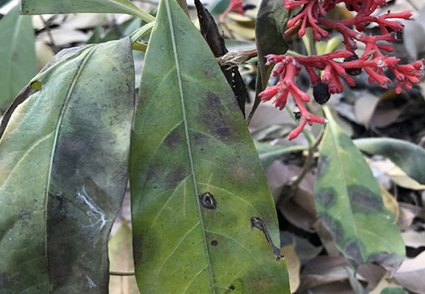Abstract
A new species of Pseudocercospora is discovered causing foliar disease on the medicinal plant Rauvolfia serpentina (Apocynaceae) from India. The new species is described and illustrated on the morphology of asexual-morphs, growth characters and multigene phylogeny. Morphologically, new species has similar characters with allied species in Pseudocercospora but differs in having catenate and branched conidia. Phylogenetic analysis using combined LSU, ITS, ACT and TEF1α data supports the isolate to be a new species of Pseudocercospora (Capnodiales, Mycosphaerellaceae).
References
Alves, A., Crous, P.W., Correia, A. & Phillips, A.J.L. (2008) Morphological and molecular data reveal cryptic speciation in Lasiodiplodia theobromae. Fungal Diversity 28: 1–13.
Bakhshi, M., Arzanlou, M., Babai-Ahari, A., Groenewald, J.Z. & Crous, P.W. (2014) Multi-gene analysis of Pseudocercospora spp. from Iran. Phytotaxa 184: 245–264. https://dx.doi.org/10.11646/phytotaxa.184.5.1
Braun, U. (1995) A monograph of Cercosporella, Ramularia and allied genera (phytopathogenic hyphomycetes). Vol. 1. Eching: IHWVerlag
Braun, U. & Urtiaga, R. (2012) New species and new records of cercosporoid hyphomycetes from Cuba and Venezuela (Part 1). Mycosphere 3 (3): 301–329. https://doi10.5943/mycosphere/3/3/5
Carbone, I. & Kohn, L.M. (1999) A method for designing primer sets for speciation studies in filamentous ascomycetes. Mycologia 93 (3): 553–556.
Chen, Y.J., Jayawardena, R.S., Bhunjun, C.S., Harishchandra, D. & Hyde, K.D. (2020) Pseudocercospora dypsidis sp. nov. (Mycosphaerellaceae) on Dypsis lutescens leaves in Thailand. Phytotaxa 474 (3): 218–234. https://doi.org/10.11646/phytotaxa.474.3.2
Crous, P.W. & Braun, U. (2003) Mycosphaerella and its Anamorphs. 1. Names published in Cercospora and Passalora. CBS Biodiversity Series no. 1, Utrecht, CBS-KNAW Fungal Biodiversity Centre.
Crous, P.W., Summerell, B.A., Carnegie, A.J., Wingfield, M.J., Hunter, G.C., Burgess, T.I., Andjic, V., Barber, P.A. & Groenewald, J.Z. (2009) Unravelling Mycosphaerella: do you believe in genera? Persoonia 23: 99–118. https://doi.org/10.3767/003158509X479487
Crous, P.W., Braun, U., Hunter, G.C., Verkley, G.J.M., Shin, H.D., Nakashima, C. & Groenewald, J.Z. (2013) Phylogenetic lineages in Pseudocercospora. Studies in Mycology 75: 37–114. https://doi:10.3114/sim0005
Deighton, F.C. (1976) Studies on Cercospora and allied genera. VI. Pseudocercospora Speg., Pantospora Cif. and Cercoseptoria Petr. Mycological Papers140: 1–168.
Kamal (2010) Cercosporoid fungi of India. Bishan Bishen Singh Mahendra Pal Singh Publication, Dehradun (UK), India. 160 pp.
Edgar, R.C. (2004) MUSCLE: multiple sequence alignment with high accuracy and high throughput. Nucleic Acid Research 32 (5): 1792–1797. https://doi:10.1093/nar/gkh340
Meswaet, Y., Mangelsdorff, R., Yorou, N.S. & Piepenbring, M. (2021) Unravelling unexplored diversity of cercosporoid fungi (Mycosphaerellaceae, Mycospaerellales, Ascomycota) in tropical Africa. Mycokeys 81: 69–138. https://doi.org/10.3897/mycokeys.81.67850
Nakashima, C., Motohashi, K., Chenm, C.Y., Johannes, Z., Groenewald, J.Z. & Crous, P.W. (2016) Species diversity of Pseudocercospora from Far East Asia. Mycological Progress 15: 1093–1117. https://doi 10.1007/s11557-016-1231-7
Park, J.H., Hong, S.B., Kim, B.S., Kim, J.Y. & Shin, H.D. (2015) Pseudocercospora leaf spot caused by Pseudocercospora nymphaeacea on Nymphaea tetragona. Tropical Plant Pathology 40: 401–404. https://doi.org/10.1007/s40858-015-0054-4
Prajapati, N.D., Purohit, S.S., Sharma, A.K. & Kumar, T. (2003) A handbook of medicinal plants: A complete source book; Agrobios (India). 436–437.
Rambaut, A. (2018) FigTree version 1.4.0. Available from: http://tree.bio.ed.ac.uk/software/figtree/ (accessed 10 April 2020)
Ronquist, F., Teslenko, M., Mark, P.V.D., Ayres, D.L., Darling, A., Höhna, H., Larget, B., Liu, L., Suchard, M.A. & Huelsenbeck, J.P. (2012) MrBayes 3.2: Efficient Bayesian phylogenetic inference and model choice across a large model space. Systematic Biology 61: 539–542. https://doi.org/10.1093/sysbio/sys029
Shivas, R.G., Marney, T.S., Tan, Y.P. & McTaggart, A.R (2015) Novel species of Cercospora and Pseudocercospora (Capnodiales, Mycosphaerellaceae) from Australia. Fungal Biology 119: 362–369. http://dx.doi.org/10.1016/j.funbio.2014.09.004
Singh, A. (2012) New report of Pseudocercospora Speg. on some medicinal plants from Sonebhadra forest UP. Biological forum- An International Journal 4 (1): 9–13.
Singh, A. & Dubey, N.K. (2012a) An ethnobotanical study of medicinal plants in Sonebhadra District of Uttar Pradesh, India with reference to their infection by foliar fungi. Journal of Medicinal Plants Research 6 (14): 2727–2746. https://doi.org/10.5897/JMPR10.895
Singh, A. & Dubey, N.K. (2012b) New host record of Cercospora apii s.lat. on medicinal plant: Diplocyclos palmatus (Linn.)Jeffery from India; Journal of New Biological Reports 1 (1): 9–11
Singh, A., Kumar, S., Singh, R. & Dubey, N.K. (2012) A new species of Corynespora causing foliar disease on Ficus religiosa from forest flora of Sonebhadra, Uttar Pardesh, India. Mycosphere 3 (5): 890–892. https://doi.org/10.5943/mycosphere/3/6/2
Singh, A., Kumar, S. & Dubey, N.K. (2013) Corynespora clerodendrigena sp.nov. causing foliar disease on Clerodendrum viscosum from Sonebhadra forest of Uttar Pradesh, India. Plant Pathology and Quarantine 3 (1): 15–17. https://doi.org/10.5943/ppq/3/1/3
Singh, A., Kumar, S., Singh, R. & Dubey, N.K. (2014) A new species of Corynespora from Sonebhadra forest of Uttar Pradesh, India. Current Research in Environment and Applied Mycology 4 (1): 149–151. https://doi.org/10.5943/cream/4/1/14
Singh, A., Singh, N.K., Singh, P.N., Singh, R. & Dubey, N.K. (2019) Additions to Ochroconis from India. Phytotaxa 427 (3): 186–199. http://doi.org/10.11646/phytotaxa.427.3.2
Singh, A., Singh, P.N., Nath, G. & Dubey, N.K. (2021) Phylogeny and Taxonomy of a novel species of Pseudocercospora from India. Turkish Journal of Botany 45: 172–180. https://doi:10.3906/bot-2012-27
Stöver, B.C. & Müller, K.F. (2010) TreeGraph 2: Combining and visualizing evidence from different phylogenetic analyses. BMC Bioinformatics 11: 7 https://doi:10.1186/1471-2105-11-7
Tamura, K., Peterson, D., Peterson, N., Stecher, G., Nei, M. & Kumar, S. (2011) MEGA5: molecular evolutionary genetics analysis using maximum likelihood, evolutionary distance, and maximum parsimony methods. Molecular Biology and Evolution 28: 2731–2739. https://doi.org/10.1093/molbev/msr121
Vilgalys, R. & Hester, M. (1990) Rapid genetic identification and mapping of enzymatically amplified ribosomal DNA from several Cryptococcus species. Journal of Bacteriology 172: 4238–4246.
Warrier, P.K., Nambiar, V.P.K. & Ramakutty, C. (1995) Indian medicinal plants: a compendium of 500 species, Orient Longman limited, 409.
Villesen, P. (2007) FaBox: an online tool box for FASTA sequences. Molecular Ecology Notes 7 (6): 965–968. https://doi: 10.1111/j.1471-8286.2007.01821.x
White, T.J., Bruns, T., Lee, S. & Taylor, J. (1990) Amplification and direct sequencing of fungal ribosomal RNA genes for phylognetics. In: Innis, M.A., Gelfand, D.H., Sninsky, J.J. & White, J.W. (Eds.) A guide to molecular methods and applications. Academic Press, New York. pp. 315–322. https://dx.doi.org/10.1016/b978-0-12-372180-8.50042-1
Yadav, S., Verma, S.K., Singh, V.K., Singh, R., Singh, A. & Kumar, S. (2021) A new species of Pseudocercospora haldiniae on Haldina cordifolia from Srinagar, Uttarakhand, India. Phytotaxa 501 (2): 281–292. https://dx.doi.org/10.11646/phytotaxa.501.2.3


